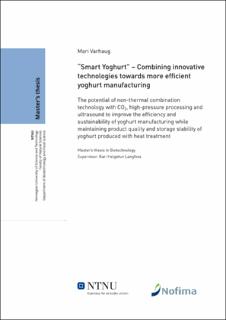| dc.contributor.advisor | Langfoss, Kari Helgetun | |
| dc.contributor.advisor | Rustad, Turid | |
| dc.contributor.author | Varhaug, Mari | |
| dc.date.accessioned | 2021-09-25T16:05:07Z | |
| dc.date.available | 2021-09-25T16:05:07Z | |
| dc.date.issued | 2020 | |
| dc.identifier | no.ntnu:inspera:56743445:4951534 | |
| dc.identifier.uri | https://hdl.handle.net/11250/2782531 | |
| dc.description.abstract | Tradisjonell varmebehandling (>80 °C, inntil 30 min) kan påvirke de ernæringsmessige og organoleptiske egenskapene til meieriprodukter negativt, og påvirker også industriens øko-fotavtrykk. Teknologier som ikke tar i bruk varme har fått oppmerksomhet, f.eks. høytrykksprosessering (HPP), ultralyd (US) og bruk av karbondioksid (CO2), enten alene eller kombinert, som et miljøvennlig alternativ til varmebehandling i meieriindustrien. Rekonstituert skummetmelk ble enten utsatt for varmebehandling (85 °C i 20 min, etterfulgt av inokulering med starter kultur) som en kontroll eller en sekvensiell behandling av CO2-HPP-US (kombinasjonsteknologi) i et 23 fullt faktorialt forsøk som følger: melkeprøven ble pakket med CO2 i en sous-vide pose og umiddelbart behandlet med HPP (400 eller 600 MPa, 5 eller 15 min), etterfulgt av inokulering og US behandling (68 kHz, 300 W, 42 °C, 5 eller 15 min). Dette førte til åtte kombinasjoner av HPP trykk, HPP tid og US tid. Alle prøvene ble fermentert ved 42 °C til pH 4.6 og yoghurten ble så lagret ved 4 °C.
Kombinasjonsteknologi, spesielt med US behandling i 15 minutt reduserte den totale fermenteringstiden sammenlignet med varmebehandlet kontroll. Yoghurtgel produsert ved HPP 400 i 15 minutter hadde viskoelastiske egenskaper sammenlignbare med kontrollen, men med større standardavvik som indikerer variasjon i geleringsprosessen. Lavere plastisk deformasjon og deformasjonskraft av yoghurten indikerte at bruk av kombinasjonsteknologi generelt resulterte i en skjørere gel med svakere bindinger innad i gelnettverket sammenlignet med varmebehandlet kontroll. Basert på total fermenteringstid, viskoelastiske egenskapene og teksturegenskaper av yoghurtgelen, ble kombinasjonsteknologien 400 MPa, 15 min, US 15 min valgt for videre karakterisering, blant annet mikrobiell vekst av startkulturen under fermentering, native- og SDS-PAGE analyse av melkeprotein og lagringsstabilitet etter 1, 7, 14, 21, 28 og 42 dagers lagring ved 4 °C. Den mikrobielle veksten under fermentering av lignende i melk behandlet med kombinasjonsteknologi og varme, noe som indikerer at behandlingsforholdene ikke påvirket veksten og den metabolske aktiviteten av starterkulturen. Under lagring hadde yoghurt produsert ved bruk av kombinasjonsteknologi og varmebehandling lignende antall kolonidannende enheter av starterkulturen, ettersyrning og titrerbar syre. | |
| dc.description.abstract | Heat treatment (>80 °C, up to 30 min) can comprise the nutritional and organoleptic properties of dairy products. To this end, non-thermal technologies have gained attention e.g. high-pressure processing (HPP), ultrasound (US) and carbon dioxide (CO2), implemented alone or in combination as an eco-friendly alternative to heat treatment. In this study, reconstituted skim milk was subjected to either heat treatment (85 C° for 20 min, followed by inoculation with starter culture) as control or to a sequential process of CO2-HPP-US (combination technology) according to the 23 full factorial design as follow: the milk sample was packaged with CO2 in a sous-vide pouch and immediately subjected to HPP (400 or 600 MPa, for 5 or 15 min) prior to the inoculation and US treatment (68 kHz, 300 W, for 5 or 15 min at 42 °C). This led to eight combinations of HPP pressure, HPP time and US time. All samples were fermented at 42 °C until the pH reached ~4.6 and the resulting yoghurt gel was stored at 4°C overnight.
The combination technology, especially with the US treatment for 15 min reduced the total fermentation time compared to the traditional heat treatment. The yoghurt gel produced with HPP 400 MPa for 15 min exhibited the viscoelastic properties comparable to those of the control sample, but with a larger standard deviation indicating a variability in the gelation process. The lower yield strain and stress of the yoghurt gel indicated that the use of the combination technology in general resulted in more brittle gel with a weaker interconnectivity within the gel network compared to the control sample. Based on the total fermentation time and the viscoelastic and textural properties of the yoghurt gel, the combination technology 400 MPa, 15 min, US 15 min, was selected for further characterisation as compared to the heat treatment, including the microbial dynamics during the fermentation and native- and SDS-PAGE analysis of the milk proteins. In addition, the storage stability of the sample was assessed after 1, 7, 14, 21, 28 and 42 days of storage at 4°C with the vial count of the starter culture, titratable acidity and whey separation. The microbial dynamics during the fermentation were similar for the samples subjected to the heat treatment and the combination technology 400 MPa, 15 min, US 15 min, indicating the processing conditions did not influence the growth and metabolic activities of the starter culture. During storage, the yoghurt gel produced with the heat treatment or the combination technology showed similar viable count of the starter culture, postacidification and titratable acidity, but different amount of whey separation. | |
| dc.language | | |
| dc.publisher | NTNU | |
| dc.title | “Smart Yoghurt” – Combining innovative technologies towards more efficient yoghurt manufacturing | |
| dc.type | Master thesis | |
